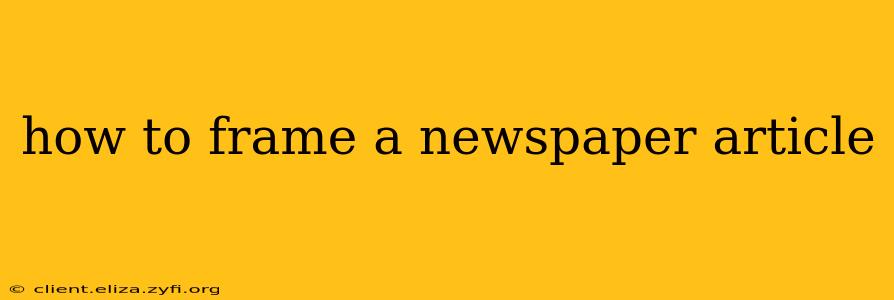How to Frame a Newspaper Article: From Idea to Impact
Crafting a compelling newspaper article involves more than just stringing together facts. It's about building a narrative that informs, engages, and resonates with readers. This guide will walk you through the essential steps, from initial brainstorming to final polishing, ensuring your article makes an impact.
1. Identifying the Core Idea and Angle:
Before you even start writing, you need a strong foundation. This begins with identifying a newsworthy topic. What's happening in your community, nationally, or internationally that deserves attention? Once you have a topic, consider your angle. What's the unique perspective or narrative you'll bring to the story? What's the central argument or theme you want to explore?
Example: Instead of simply reporting on a local election, you might focus on the impact the election will have on the local economy, or the rise of a particular candidate who defied expectations.
2. Conducting Thorough Research:
A well-framed article relies on strong research. This involves:
- Interviewing Key Individuals: Gather firsthand accounts and perspectives from people directly involved in the story.
- Accessing Reliable Sources: Consult official documents, reports, studies, and reputable news outlets.
- Verifying Information: Double-check all facts and figures to ensure accuracy. This is crucial for maintaining credibility.
3. Structuring Your Article:
Newspaper articles typically follow an inverted pyramid structure. This means the most important information is presented first, followed by supporting details in decreasing order of importance.
- Headline: Grab the reader's attention with a concise and impactful headline.
- Lead Paragraph (Lede): Summarize the most important aspects of the story in the first paragraph. Answer the who, what, when, where, why, and how.
- Supporting Paragraphs: Provide details, evidence, and context to support your lead. Use quotes from interviews and other sources to enhance your narrative.
- Conclusion: Offer a concluding statement that summarizes the key takeaway or provides a sense of closure.
4. Writing Style and Tone:
Newspaper articles demand clear, concise, and objective writing.
- Clarity: Use simple language and avoid jargon. Write in a way that is easily understood by a broad audience.
- Objectivity: Present information fairly and avoid expressing personal opinions. Stick to the facts.
- Conciseness: Use precise language and avoid unnecessary words.
- Accuracy: Verify all facts and information before publication.
5. Editing and Proofreading:
Before submission, carefully review your article for errors in grammar, spelling, punctuation, and style. A second pair of eyes can be invaluable in catching mistakes you may have missed.
How do I choose a good angle for my newspaper article?
Choosing a strong angle involves identifying the most compelling aspect of your story. Ask yourself: What's the most interesting or significant element? What's the human interest angle? What's the unique perspective you can offer? Is there a conflict, a surprise, or an unexpected twist? Focusing on a compelling angle will make your article more engaging and memorable for readers.
What are some common mistakes to avoid when writing a newspaper article?
Common mistakes include: poorly written leads, inaccurate information, lack of objectivity, overly complex sentence structures, grammatical errors, and a failure to properly attribute sources. Careful planning, thorough research, and diligent editing can help you avoid these pitfalls.
How do I make my newspaper article more engaging?
Engaging readers involves employing strong storytelling techniques. Use vivid language, compelling quotes, and descriptive details to bring your story to life. Break up large blocks of text with shorter paragraphs and subheadings. Consider including relevant images or multimedia elements to enhance the overall impact.
By following these steps and addressing these common questions, you can significantly improve your ability to frame a newspaper article that is both informative and engaging for your target audience. Remember, a well-crafted article isn't just about reporting facts; it's about crafting a compelling narrative that informs, entertains, and resonates with readers.
